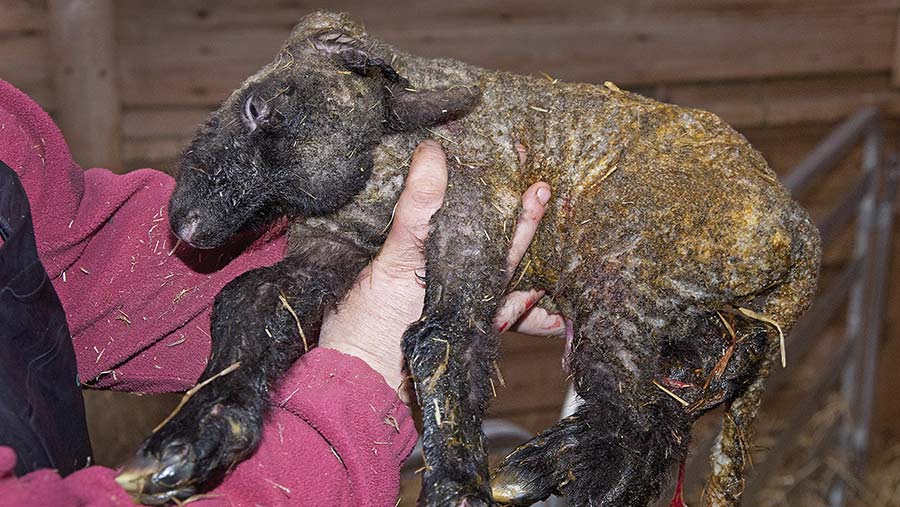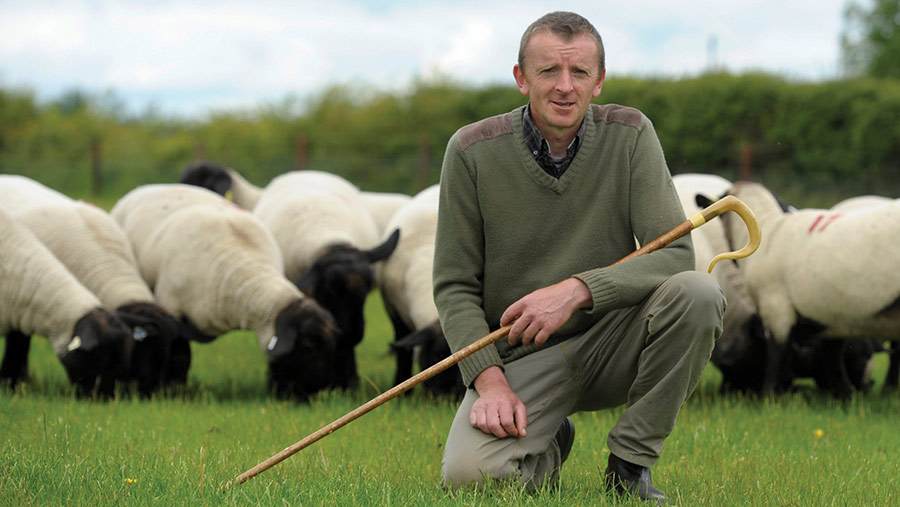Schmallenberg outbreak hits early lambing flocks
 © Jonathan Page
© Jonathan Page Growing numbers of flocks are being struck by the deadly Schmallenberg virus in the south of England, Midlands and Wales.
Vets are urging farmers with deformed lambs to send them for post-mortem so they can be tested for the virus. This can be done free of charge through the Animal and Plant Health Agency (Apha).
Currently, a vaccine is not commercially available, but vets are hopeful this might change if more flocks are identified as infected.
See also: Expert advice on assessing and managing lambing difficulties
Vet Kirby Dobson from Tyndale Vets in Gloucestershire estimates that 20 of their early lambing flocks have been blighted by the virus.
The practice covers a 150-mile radius from the South West to Worcester and crosses the Severn Bridge into South Wales.
“So far it has mainly been pedigree flocks that lamb in January. Most of these are Suffolk and Texel and have lost up to 50% of lambs,” she explains.
The last significant wave of Schmallenberg happened in 2016-17, when Apha confirmed 141 sheep farms in England, Wales and Scotland had tested positive for the virus, as well as 76 cattle holdings.
Cause of virus outbreak
Kirby believes the sharp rise in cases this year is the result of warm and wet weather in late autumn. This would have presented ideal conditions for biting midges, which transmit the disease.
The most susceptible stage for foetal deformities is days 25-50 of gestation in sheep, with older foetuses able to clear the virus.
She says typical malformations to look for include fused neck and legs or the neck bent in an S-shape.
This makes it extremely difficult for the lambs to pass safely through the pelvic canal and any live lambs are unviable and must be euthanised.
Clinical signs of Schmallenberg
- Abortions
- Stillbirths
- Foetal abnormalities
- Reduced milk yield
- Fever
- Loss of appetite
- Diarrhoea
Source: National Animal Disease Information Service
Schmallenberg usually runs in cycles of three to five years, but this latest outbreak does not fit this pattern, she adds.
“Maybe immunity has waned, and the midge challenge has been higher this year. Farmers were still getting flystrike in November [because conditions were so mild].
“There is no definite pattern to the disease spread in our area. When I spoke to Apha, they said it was not fitting the three-to-five-year pattern of immunity.”
Kirby says it is difficult to gauge if this is only the tip of the iceberg, although she remains hopeful the worst is over, given that later lambing flocks have seen improved scanning rates compared with earlier ones.
“I’m hoping the higher scanning rates indicate ewes haven’t been infected, but it is just a hunch. We will have to wait and see,” she says.
Wider picture
Farm First Vets in Abergavenny, South Wales, says it has had “several reports” of Schmallenberg.
Belmont Farm and Equine Vets, Herefordshire, says it is turning out to be a difficult time for many of its clients. “We have been called out to a large number of farms who are suffering with Schmallenberg virus.”
Further north, Tim O’Sullivan, from Shropshire Farm Vets, near Shrewsbury, says he attended a farm to help lamb a triplet.
The ewe had two deformed lambs in one horn of the uterus and an unaffected lamb on the other side.
They probably had separate placentas, he says, adding: “We had rams at the back end that failed Schmallenberg blood tests, so we know it is present.”
Affected flocks
South Wales
One flock afflicted was Pat Greaney’s early lambing flock of pedigree Suffolks. The 17-ewe flock, based near Raglan in South Wales, belongs to his daughters Lucy and Keira.
The ewes were artificially inseminated on 6 August to lamb on 28 December. One ewe had reabsorbed at scanning, but Schmallenberg was not identified until 29 December.
“I went to lamb a ewe and I could only feel one back leg. I thought it was contracted tendons, so I called the vet to do a C-section.

© Alfie Shaw
“The first lamb’s bottom jaw was not fully formed, its ribs were flat, and the front legs were fused backward in a lying position. It died within minutes of being born,” Pat recalls.
“We lost both lambs and the ewe never recovered from the operation,” he adds.
In total, the Greaneys have lost two ewes and six lambs – all doubles – to the disease, representing 20% of their small flock.
“The financial loss is bad enough, but the hardest thing was looking at the lambs. I’ve seen lots of lambings, but this is gruesome – the image is etched in your mind forever.”
He says he is hearing of more flocks locally that have the disease and warns others not to take shortcuts with vet intervention in case ewes require a C-section or the lambs need putting down.
Good aftercare of ewes birthing infected lambs is also imperative, he adds.
They managed to save one ewe by promptly treating her with anti-inflammatories and antibiotics, although he concedes the lambs were breached and birthed easier, despite the deformities.
With 45 cows having started to calve, Pat is concerned some of the later calving animals could be harbouring foetuses infected with Schmallenberg.
“We had more barren cows than usual, but we put it down to heat stress at the time.
“There’s nothing we can do apart from expect the worst and hope for the best.”
Worcestershire/Shropshire
Another farmer from the Worcestershire/Shropshire border has lost more than 50 lambs from his flock of 175 early lambers. On top of this, scanning percentages were down 20%.
He estimates the virus has already cost him £10,000.
The farmer, who wishes to remain anonymous, says: “About 90% [of ewes] are presenting nowhere near right and can’t be lambed without assistance.”
Although he has avoided having to call the vet for C-sections, there are still two large groups left to lamb.
He adds: “A lot of farmers nearby are having similar problems, so we are not on our own, but that doesn’t make it any better.”
Gloucestershire
Katie Ford lambs a flock of 800 mixed ewes with her parents near Newent. They have lost 17 lambs and two ewes from an early lambing group of Suffolk crosses.
They were synchronised to lamb after Christmas. Six scanned empty and 25 of the remaining 60 ewes had lambs with Schmallenberg. She also lost one ewe.
Since then, two recipient ewes lambed healthy Dutch Spotted lambs.
“We had Schmallenberg very badly in 2012. Schmallenberg presents itself differently this time around – the lambs are more malleable and are easier to lamb.”
With the next batch starting to lamb in February, she hopes the remainder of the flock will be unaffected.
“The midges have been [active] until late last year, so it could affect more. Only time will tell.”
Support networks
If you are finding lambing difficult, do not suffer in silence. For support, contact the Royal Agricultural Benevolent Institution on 0800 188 4444 or the Farming Community network 03000 111 999.
